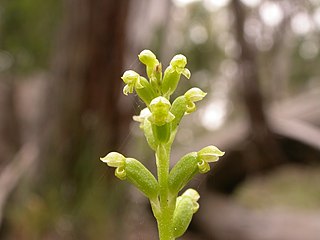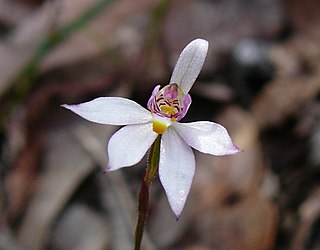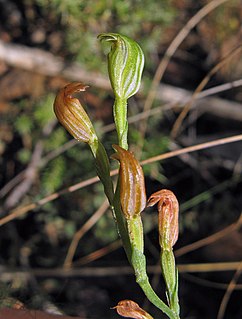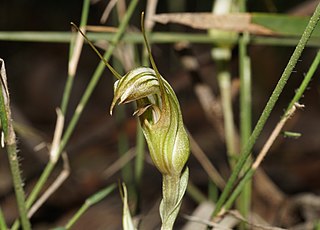
Caladenia, commonly known as spider orchids, is a genus of 350 species of plants in the orchid family, Orchidaceae. Spider orchids are terrestrial herbs with a single hairy leaf and a hairy stem. The labellum is fringed or toothed in most species and there are small projections called calli on the labellum. The flowers have adaptations to attract particular species of insects for pollination. The genus is divided into three groups on the basis of flower shape, broadly, spider orchids, zebra orchids and cowslip orchids, although other common names are often used. Although they occur in other countries, most are Australian and 136 species occur in Western Australia, making it the most species-rich orchid genus in that state.

Gastrodia, commonly known as potato orchids or as 天麻属 , is a genus of terrestrial leafless orchids in the family Orchidaceae, about ninety of which have been described. Orchids in this genus have fleshy, upright stems and small to medium-sized resupinate flowers with narrow sepals and petals. They are native to Asia, Australia, New Zealand, central Africa, and various islands of the Indian and Pacific Oceans.

Dipodium punctatum, commonly known as the blotched hyacinth-orchid, is a leafless orchid that is a native to eastern and south-eastern continental Australia. In summer it produces a tall flowering stem with up to sixty pale to bright pink flowers with heavy red blotches. A widespread and common species it is often confused with D. roseum and some authorities regard it as a synonym of D. squamatum.

Caleana, commonly known as duck orchids, is a genus of flowering plants in the orchid family, Orchidaceae that is found in Australia and New Zealand. The Australian species are found in all states but have not been recorded in the Northern Territory. Duck orchids have a single leaf and one or a few, dull-coloured, inconspicuous flowers. Most species are found in Western Australia but one species occurs in eastern Australia and one occurs in eastern Australia and New Zealand. Orchids in this genus as well as the hammer orchids (Drakaea) are pollinated by male thynnid wasps.

Calochilus paludosus, commonly known as the red beard orchid or red beardie, is a species of orchid native to Australia and New Zealand. It has a single fleshy, light green leaf and up to nine greenish flowers with reddish stripes. The labellum has a dull red or coppery coloured beard and lacks the "eye" spots of other beard orchids.

Dendrobium aemulum, commonly known as the ironbark feather orchid or white feather orchid, is an epiphytic orchid in the family Orchidaceae and grows on trees that retain their bark, especially ironbarks. It has reddish or purplish pseudobulbs, two to four leathery leaves and up to seven white, feathery flowers. It grows in open forest in Queensland and New South Wales.

Cryptostylis hunteriana, commonly known as the leafless tongue-orchid is a flowering plant in the orchid family Orchidaceae and is endemic to south eastern Australia. It is leafless but has up to ten green flowers with a more or less erect, dark reddish brown labellum.

Orthoceras strictum, commonly known as the bird's-mouth orchid or horned orchid, is a species of orchid native to eastern and southern Australia, New Zealand and New Caledonia. It has between two and five linear leaves and up to nine yellowish green, brownish or blackish flowers with two long, erect to spreading lateral sepals.

Microtis parviflora, commonly known as the slender onion-orchid, is a species of orchid which is native to Australia and New Zealand. It occurs in all states of Australia but is not known from the Northern Territory and may not occur in Western Australia. As with others in the genus, it has a single erect, smooth, tubular leaf and up to eighty flowers on an erect flower spike.

Caladenia alata, commonly known as the fairy orchid, is a plant in the orchid family Orchidaceae and is found in south-eastern Australia and New Zealand. It is a ground orchid with small, usually short-lived flowers, which have relatively stiffly held petals and sepals and reddish-purple bars on the labellum.

Caladenia minorata, commonly known as the small waxlip orchid, is a plant in the orchid family Orchidaceae and is endemic to eastern Australia. It is a ground orchid with a single very hairy leaf and one or two deep violet-blue flowers. It has been known as Glossodia minor since its description by the prolific Scottish botanist Robert Brown in 1810, but recent discoveries suggest its inclusion in the genus Caladenia. It is similar to Caladenia major but is smaller in all its parts.

Pterostylis parviflora, commonly known as the tiny greenhood, is a species of orchid endemic to south-eastern Australia. As with similar orchids, the flowering plants differ from those which are not flowering. The non-flowering plants have a rosette of leaves but the flowering plants lack a rosette at the base but have up to eight tiny green, white and brown flowers.

Pterostylis ophioglossa, commonly known as the snake-tongue greenhood, is a species of orchid endemic to eastern Australia. It has a rosette of leaves at the base and a single dull green, white and brown flower with a deeply notched labellum.

Thelymitra carnea, commonly called the tiny sun orchid or pinkish sun orchid, is a species of orchid that is native to Australia and New Zealand. It has narrow, almost cylindrical leaves and up to four relatively small pale to deep pink flowers on a wiry, zig-zag stem.
Gastrodia crebriflora, commonly known as dense potato orchid, is a leafless terrestrial mycotrophic orchid in the family Orchidaceae. It has a pale brown flowering stem and up to thirty five crowded, drooping, white to pale brown flowers. It is only known from the Blackdown Tableland in Queensland, Australia.

Gastrodia entomogama, commonly known as the Brindabella potato orchid, is a leafless terrestrial mycotrophic orchid in the family Orchidaceae. It has a dark brown or blackish flowering stem with up to sixty brown, warty, tube-shaped flowers. It is only known for certain from the Australian Capital Territory.
Gastrodia lacista, commonly known as the western potato orchid, is a leafless terrestrial mycotrophic orchid in the family Orchidaceae. It has a thin brown flowering stem with up to fifty small, drooping, fawn and white, tube-shaped flowers. It grows in forest and woodland in the south-west of Western Australia.

Gastrodia procera, commonly known as the tall potato orchid, is a leafless terrestrial mycotrophic orchid in the family Orchidaceae. It has a robust, dark brown to blackish flowering stem with up to seventy cinnamon brown, tube-shaped flowers that are white inside. It grows in high rainfall forest in southeastern Australia.
Gastrodia urceolata, commonly known as white potato orchid, is a leafless terrestrial mycotrophic orchid in the family Orchidaceae. It has a pale brown, fleshy flowering stem and up to fifty five upright, white to pale brown flowers. It is only known from a single population near Atherton in Queensland.
Gastrodia vescula, commonly known as small potato orchid, is a leafless terrestrial mycotrophic orchid in the family Orchidaceae. It has a very thin, brittle, light brown flowering stem with up to three pale brown flowers that are white on the inside. It is only known from a small area near the border between South Australia and Victoria.
















